| Denzil Walton, an English writer based in Belgium,
has been asking me about my local booklets and how I print and publish
them. If you're interested, here's what I told him:
 Pocket-sized Publications
Pocket-sized Publications
The pocket size (A6, about 6 x 4 inches) works so well. Today I've been
printing out more copies of Waterton's Park in the background
to other activities. I've had the covers printed professionally but my
oversize A3 laser printer is fine for the black and white inner pages
(and even for colour in a limited way).
Willow Island: is that your own company?
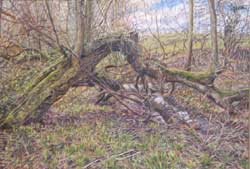 Yes,
I couldn't very well have books by Richard Bell . . . published by
Richard Bell, so I named Willow Island Editions after
a clump of crack willows that I can see from my studio window (left,
in an acrylic on canvas I painted of them). The stream, Coxley Beck,
forks then rejoins to create an island half the size of a tennis court. Yes,
I couldn't very well have books by Richard Bell . . . published by
Richard Bell, so I named Willow Island Editions after
a clump of crack willows that I can see from my studio window (left,
in an acrylic on canvas I painted of them). The stream, Coxley Beck,
forks then rejoins to create an island half the size of a tennis court.
Did you set it up yourself as an outlet for your books?
 Yes,
my first product was a guide to my small home town of Horbury,
which I put together from drawings I'd previously made of the older corners
of the town, annotated with short captions based on local history books,
press cuttings and the bits and pieces of local knowledge that I've picked
up over the years. I managed to get the whole thing designed, written
and printed in just 3 weeks, in time for an exhibition of my artwork at
the local library. It is still in print and I must have sold 1,500 copies,
probably more like 2,000. Yes,
my first product was a guide to my small home town of Horbury,
which I put together from drawings I'd previously made of the older corners
of the town, annotated with short captions based on local history books,
press cuttings and the bits and pieces of local knowledge that I've picked
up over the years. I managed to get the whole thing designed, written
and printed in just 3 weeks, in time for an exhibition of my artwork at
the local library. It is still in print and I must have sold 1,500 copies,
probably more like 2,000.
Money Matters
If so, how, if may I be so bold to ask, is it profitable, as
it is quite a niche market?
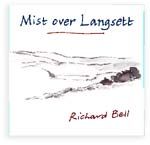 Well,
that's why it's profitable, because it is a niche market. Anything
local sells. Imagine trying to market a novel! Well,
that's why it's profitable, because it is a niche market. Anything
local sells. Imagine trying to market a novel!
We can easily keep tabs on about 6 local outlets who between them have
sold thousands of books. The ideal would be to have 20 or 30 titles all
in print, selling steadily but when I'd completed 7 little local books
I felt the need for a creative challenge so I went on to my Sushi
Sketchbooks (left), which are a bit more specialised but
they've given me the opportunity to develop ideas, without being bound
by the format and topographic focus of the informative local studies booklets.
I can explore atmosphere and my feelings about the places I draw. All
the Sushis are drawn on location.
Or is it a sideline and you have a full time job elsewhere?
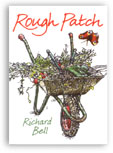 I've
gradually cut out everything else - teaching, exhibitions, commissions.
My next step, if I can do it, is to produce more substantial sketchbooks.
If Rough Patch does OK, that will give me the opportunity to
publish a sketchbook about the Peak District. I've
gradually cut out everything else - teaching, exhibitions, commissions.
My next step, if I can do it, is to produce more substantial sketchbooks.
If Rough Patch does OK, that will give me the opportunity to
publish a sketchbook about the Peak District.
The great thing about publishing the little books at home, especially
if you're printing on demand as I do for the slower sellers, is that you
can keep a reasonable stock of each title in Ikea boxes on a shelf in
the spare bedroom, which is now Barbara's office for the invoice side
of the business. The problem with getting a 160 page A5 paperback like
Rough Patch printed is that 4,000 copies amounts to four pallet
loads and they're stacked in our back bedroom, here in the studio and
at Barbara's mum's.
How I will manage when I've several bigger books in print, I don't know!
Perhaps I'll have to look for warehouse space somewhere.
Bursting into Print
So you print at home?
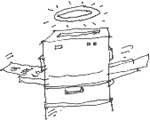 That's
the basis of it: all the Sushis were printed at home. I just do 5, 10,
20 at a time, whatever. With the local books I'll sometimes do 100 at
a time, but if anything shapes up to be a steady seller like Sandal
Castle I'll get it printed professionally 1,000 at a time - that's
still just 3 or 4 boxes with such a small book. This probably works out
at less than the cost of the toner and paper and it saves days of my time,
but printing at home, in small runs, allows me to experiment. There's
no outlay, except in time. That's
the basis of it: all the Sushis were printed at home. I just do 5, 10,
20 at a time, whatever. With the local books I'll sometimes do 100 at
a time, but if anything shapes up to be a steady seller like Sandal
Castle I'll get it printed professionally 1,000 at a time - that's
still just 3 or 4 boxes with such a small book. This probably works out
at less than the cost of the toner and paper and it saves days of my time,
but printing at home, in small runs, allows me to experiment. There's
no outlay, except in time.
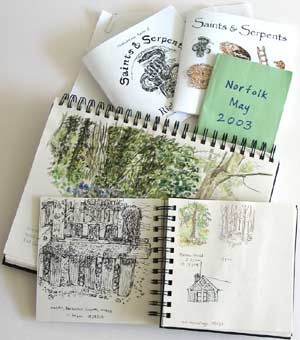
Turning my original sketchbooks into
the Sushi Sketchbook Saints and Serpents.
|
Design and layout
May I ask what desktop publishing software package you
use?
 Microsoft
Publisher for the local books (which works best with my
printer) and Macromedia FreeHand for the Sushis
(which is compatible with the Macs used by professional printers). Microsoft
Publisher for the local books (which works best with my
printer) and Macromedia FreeHand for the Sushis
(which is compatible with the Macs used by professional printers).
Do you layout as for an A4 page and then reduce to A6
at the printing stage?
No, but a lot of the pre-existing drawings were reduced in size
to fit in my local books. For the Sushi's I invariably
draw same size.
Do you then cut and staple everything together at home
also?
Yes, I've got a hand-operated guillotine (builds
up your muscles) and a Stanley Bostitch booklet stapler
(a saddle stapler that you can put a folded book on). I once looked
at a bigger guillotine but it would have taken up half my room.
The Big Issue
Sorry if I am bugging you with all these questions, but
I just love this concept of yours and can already visualise a series
of booklets on Belgian walks.
Sounds like a good idea.
Really, the big decisions aren't technical; they're the decisions
we all have to deal with between freedom and commitment.
I want the freedom to draw, so I publish the books but, because
the books are so successful I find I have less and less time to
draw!
You can't win! 
Richard Bell, richard@willowisland.co.uk
|
Links
 Denzil
Walton, an English freelance technical copywriter based in
Brussels ('you'll find the Fôret de Soignes is full Siberian
chipmunks' writes Denzil in one of his nature walk articles) Denzil
Walton, an English freelance technical copywriter based in
Brussels ('you'll find the Fôret de Soignes is full Siberian
chipmunks' writes Denzil in one of his nature walk articles)
Willow Island
Editions - where you can now buy my booklets online. |
 Denzil
Walton, an English freelance technical copywriter based in
Brussels ('you'll find the Fôret de Soignes is full Siberian
chipmunks' writes Denzil in one of his nature walk articles)
Denzil
Walton, an English freelance technical copywriter based in
Brussels ('you'll find the Fôret de Soignes is full Siberian
chipmunks' writes Denzil in one of his nature walk articles)